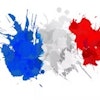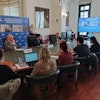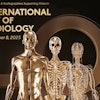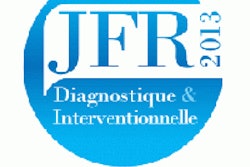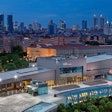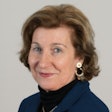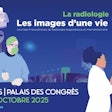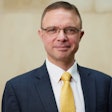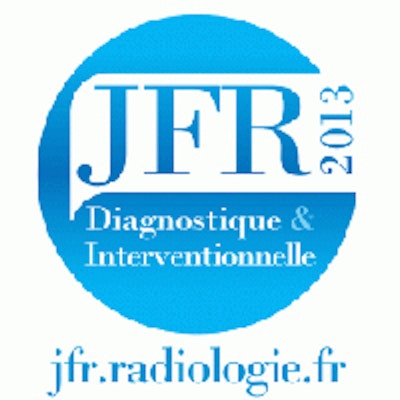
Cancer imaging will come under the spotlight during next month's Journées Françaises de Radiologie Diagnostique et Interventionnelle (JFR, French Congress of Diagnostic and Interventional Radiology) in Paris. The five-day event, to be held from 18 to 22 October, looks set to attract more than 18,000 delegates eager to hear discussion on a wide range of clinical sociopolitical issues and participate in the scientific and educational program.
A cornerstone of this year's imaging against cancer theme is the Antoine Béclère lecture presented by Dr. Jean-Paul Vernant, professor of hematology at l'Hôpital de la Pitié-Salpêtrière in Paris. Tasked with formulating recommendations for the nation's Cancer Plan III, Vernant is likely to underline the relevance of oncological radiology, as well as flagging its role in his proposals to address social inequalities associated with the disease. On 30 August 2013, he presented recommendations to two government ministers (health, and teaching and research) on research, professional training and practice, treatment course for patients, and life during and after cancer.
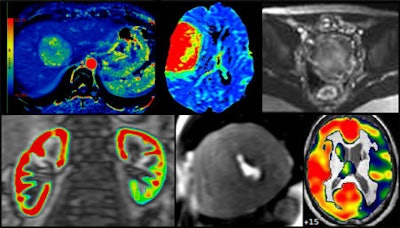 Perfusion imaging will come under scrutiny at JFR 2013, and will be the main theme of the Second Forum of Advanced Techniques on Monday 21 October.
Perfusion imaging will come under scrutiny at JFR 2013, and will be the main theme of the Second Forum of Advanced Techniques on Monday 21 October.Treatment for cancer sufferers is equal across France, but the country lacks equality in prevention and screening, notably in tackling exposure to alcohol and cigarettes, as well as in getting women screened for breast cancer, according to Dr. Laurent Verzaux, president of the Société Française de Radiologie (French Society of Radiology, SFR).
"This is about culture and access to information so that all sectors of society get early diagnosis," said Verzaux, who is a breast imaging specialist at SCM IRM, Le Havre Center.
One of the biggest challenges remains at the equipment level, namely the lack of MR systems in France, he noted. Therefore, Vernant's recommendation to increase this number, as was envisaged in 2009, is welcomed by radiologists.
"France is still lagging behind most of Europe with 10 machines per million inhabitants, while Germany has 30 scanners per million, and the average across member states is 20 scanners per million inhabitants. It seems that we are always playing catch up," Verzaux told AuntMinnieEurope.com. "It's a true shame because France's younger radiologists are highly educated in MRI, but can't practice what they have trained for."
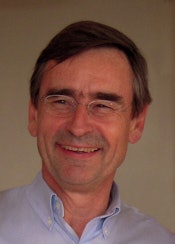 France still lags behind most of Europe with 10 machines per million inhabitants, according to Dr. Laurent Verzaux.
France still lags behind most of Europe with 10 machines per million inhabitants, according to Dr. Laurent Verzaux.
He attributes this gap in the number of MR units between France and the rest of Western Europe to a lack of trust between the governmental health insurers and doctors. The government only sees the expense of MRI, and not the savings to be made, he explained. He pointed to the obviation of unnecessary examinations through timely use of MRI, and to the resulting optimized patient care that can reduce hospitalization times, thereby ensuring fast appropriate treatment in the case of stroke patients, for example.
Cancer imaging has for many years been a priority among France's radiological G4: the Collège d'Enseignants de Radiologie Française, (CERF, French College of Radiology Teachers), the Fédération Nationale de Médecins Radiologues, (FNMR, The National Federation of Independent Radiologists), the SFR, and the Syndicat des Radiologues Hospitaliers, (SRH, Syndicate of Hospital Radiologists).
Between them, they have devised and established strategies for improved quality control and professional structure. Consequently, radiologists must undergo specific training and adhere to a minimum activity threshold among other criteria for cancer imaging. French radiologists involved in breast cancer screening, for example, must first-read at least 500 mammograms per year, regardless of department size, and second-readers must handle 2,000 mammograms and reports per year. These new models of quality control and organization instigated by the profession itself now must be supported by the government, according to Verzaux.
"We can't insist on higher quality but lower the rate of reimbursement for radiological acts. We are in one of the most administrative countries in Europe and there must be coherence between what the authorities want and how they achieve it," he said.
JFR 2013: Scope and themes
Fast diagnosis, appropriate exploration and in-depth personalized imaging exams, best follow-up, and access for all will be covered in 27 sessions dedicated to imaging against cancer. These sessions will be overseen by Dr. Frank Boudghene Stambouli, professor of radiology at Tenon Hospital, University of Paris 6, and president of the Federation of Cancer Imaging at the SFR.
 An extensive oncology imaging program aims to touch on all aspects of radiology that involve cancer patients, according to Dr. Frank Boudghene Stambouli.
An extensive oncology imaging program aims to touch on all aspects of radiology that involve cancer patients, according to Dr. Frank Boudghene Stambouli.
"All organ-specific imaging specialties will emphasize the theme of cancer imaging, both in the courses and the workshops they organize during the meeting, from detection to follow-up," he said. "There will also be sessions on the latest research in tumoral response, which is a great challenge for radiologists, as well as recent developments in MRI."
Dr. Agnes Buzyn, president of the French National Cancer Institute (INCa), will participate in a session about imaging against the inequalities facing cancer, and will be joined by oncologists from different institutions.
"We want to work for access to pertinent imaging for all patients everywhere, regardless of where they live," said JFR President Dr. Jean François Meder, PhD, head of neuroimaging at Sainte-Anne Hospital in Paris.
In addition to 27 cancer sessions, 24 posters will constitute the "Imaging against cancer" avenue on level 3.7 of the Palais des Congrès, which complements the other interactive spaces of the JFR, such as the Forum of Advanced Techniques on Monday 21 October.
"The objective of this forum is to answer any questions about perfusion imaging through the different activities proposed, whatever modality is used," said forum organizer Dr. Myriam Edjlali-Goujon, a neuroradiologist at Sainte Anne Hospital and past representative of French residents and fellows in the junior SFR section.
This year, in addition to a large open-access panel of postprocessing workstations that can be tested live all day, three workshops will be led by a group of experts presenting clinical cases in which perfusion imaging is applied to the diagnosis, evaluation, and monitoring of lesions. Delegates will also get to hear about new technologies and advanced techniques from industry figures during the lunch break.
Discussion will also focus on the crossroads of research, an initiative of the SFR, junior SFR, and CERF, its purpose being to promote research and management in imaging and to reward recent imaging studies and developments. The success story in this area is Imaios, which began life as a French e-learning tool for interactive MRI training and has now expanded to clinical and anatomy modules. It is now accessible through mobile phone apps. Imaios will be presented on Friday 18 October, she noted.
Interventional Village
Meder said this year's congress will underline radiology's central and growing role not only in the detection, diagnosis, and follow-up of most pathologies, but also in their treatment through image-guided interventional radiology (IR) techniques. After last year's success, the Interventional Village will be open to all delegates from 18 to 20 October. It will pivot on five interactive sessions, and a platform of equipment for live testing. With IR in oncology at its heart, the village will propose courses on multidisciplinary approaches with virtual consultation meetings and reviews. Oncologists, gastroenterologists, and surgeons will participate in these sessions.
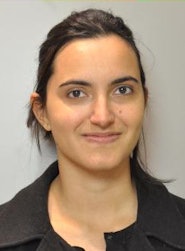 Comprehensive perfusion imaging training at the Advanced Techniques Forum will cover technical aspects and practical applications, according to Dr. Myriam Edjlali-Goujon.
Comprehensive perfusion imaging training at the Advanced Techniques Forum will cover technical aspects and practical applications, according to Dr. Myriam Edjlali-Goujon.
Despite imaging's central role in ground-breaking treatment, a shortage of radiologists in France remains a brake on the development of interventional radiology, he explained.
"The SFR, along with the other associations of the G4, wants to ensure an improvement in medical demographics and an increase in the number of radiology residencies which today is insufficient," Meder said. "The numbers of anesthetists necessary for a quality service are ensured by an increase in the number of residencies available. We have to show that radiology, like anesthetics, is central to patient care to ensure an enduring satisfactory level of service."
The number of residents admitted to radiology between 2013 and 2018 will not allow quality of care to be maintained, according to a press statement by the professional council of the G4 in July. Across the five years, only 1,114 residents will be trained in radiology, not the 1,300 demanded by the specialty to cope with the growing demands of medical imaging.
Radiology in France already has the highest number of vacancies among medical disciplines, with 37% of full-time positions unfilled. Without an increase in the number of radiologist trainees, this situation will worsen due to the demographics of radiologists, 38% being older than 55, and due to the increasing indications for diagnostic and interventional imaging.
The council insists that radiology services can accommodate this higher number of residents and train them in order to effectively participate in patient care.
On a similar funding note, radiologists acknowledge France is home to an increasing number of projects pivoting on electronic patient file-sharing and telemedicine that are costly to establish, but ultimately will lead to a quality of service to which the government aspires.
"These projects can't be paid for solely by professionals through the price of radiological acts. Instead, such projects must be accompanied by real financial investment by government," Verzaux noted.
JFR will not just be an arena for mobilizing radiologists in sociopolitical issues, and informing them about the latest e-health projects, it will also be a meeting place to exchange with radiologists from other nations. This year the spotlight is on the Tunisian Society of Radiology, which has organized a day of Tunisian-imaging related sessions. There will also be more sessions in English due to a large Anglophone presence, notably of Asian radiologists, and in Spanish due to participation by South American colleagues, according to the organizers. These take place predominantly on 19 and 20 October, with simultaneous translation for specific sessions.
In 2012, 2,600 foreign delegates from 74 different countries attended JFR. Of these, around 400 were from non-French speaking countries.
"A few years ago the meeting was exclusively in French, now we have a chance to exchange experiences with other nations making the JFR a more enriching congress for all," Meder said. "This is not just a congress for the French and for French speakers, and with each meeting we work at making what we have been doing for years with our international colleagues a little bit more official."
